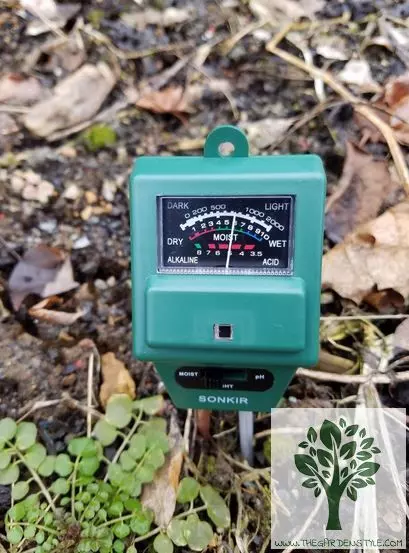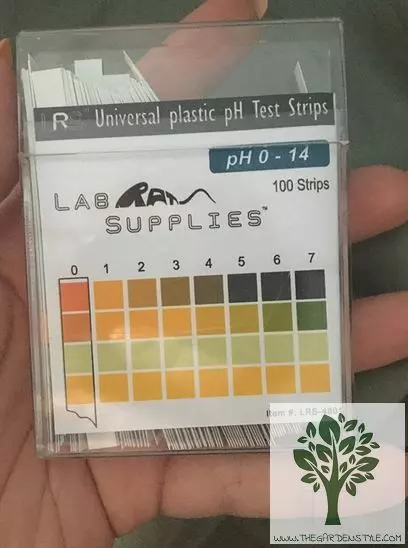Many plants have specific requirements for the acidity or alkalinity of the soil they are in, so it is common when looking up the care of some plants to see things like “requires acidic soils” or certain pH requirements. Because of this, it becomes necessary to know how to measure soil pH at home and be able to alter it in case of soil pH problems. Continue reading to learn all about how to measure soil pH in this article.
Table of Contents
Why It Is Important to Measure the pH of The Soil
Why It Is Important to Measure the pH of The Soil? The pH marks, as we just mentioned, the level of acidity or alkalinity of your soil, so it is very important to know what you can or cannot grow in it. Soil tends to have a pH close to neutral, but the natural composition of certain soils can make it more acidic or alkaline, as well as certain cultivation techniques or the use of some fertilizers or substances.
Without an adequate pH, the beneficial microorganisms in the soil will not be able to maintain themselves, nor will the plants be able to absorb the nutrients they need. The so-called acidophilic plants, such as hydrangeas, gardenias, azaleas, and camellias, among others, are known in this case. These plants cannot develop properly in soils with a too high pH, for example, the University of North Dakota mentions that hydrangeas need a pH between 6 and 6.2.
How To Measure Soil pH at Home
How to Measure Soil pH? There are several ways to measure soil pH, first I will begin by explaining a more traditional and longer process. Finally, I will explain how to measure soil pH with a tester (very inexpensive). I believe that all gardeners should have a pH tester among their gardening tools to get an accurate result.
1- Buy pH strips, which you can easily find in any hardware store or supermarket, or even buy it online on large platforms without any difficulty. You should use the same pH test strips that we use (Order here).
2- You will also need distilled water, which must be distilled for its neutral pH of 7. If it is tap water or mineral water, the test result will not be valid, as the water will alter it. Distilled water can also be purchased without problems in hardware stores, supermarkets, and department stores.
3- Ready this, it only remains to get the soil sample of which you want to measure the pH, which cannot be taken at a random point because the soil can undergo alterations in punctual places. Divide the area of land whose pH you want to measure into about 10 plots, and take a sample from each of these areas, all the same sizes. It is advisable not to take the sample from the surface but from a depth of between 4” and 18” (10 and 45 cm).
4- Then mix them with distilled water, as much weight in water as the weight has the sample, stir them well, and let the samples stand for a couple of hours.
5- After this, just dip the strip in the water of the container, and it will adopt the color corresponding to the pH of the soil, which you will have to compare with the guide that comes with the strips.
Another more imprecise but quicker method to measure soil pH is to use vinegar. To measure soil pH with vinegar. Simply add vinegar to your soil sample and look closely to see if bubbles appear or not. If there are, it means that the soil is alkaline, i.e., its pH is more than 7.
What is The Fastest Way to Test The pH of Soil
What is The Fastest Way to Test The pH of Soil? There is also a much faster and more economical method of measuring soil pH, and that is to use an analog or digital pH meter. The great advantage of these devices is that they not only measure the pH of the soil, but also the moisture and the illumination of the plants.
There are two types of pH meters on the market, some are analog and do not require batteries. Others are electronic and use a small battery but last a long time. In our house, we have the analog meter, and we use it in all the plants that we want to measure the pH of the soil.

- Kindly NOTE: This soil tester can not be applied to test pH value of any other liquid. If the soil is too dry the indicator will not move, and water it before testing.
- 3 METERS IN ONE: Soil moisture level, Soil pH value and Sunlight level could be tested easily according to your need by switching the function button of this soil meter.
- NO BATTERY NEEDED: Simply insert the meter into soil, wait few minutes, accurate test results will be displayed on the readout panel. No battery is needed.
How to Lower pH in Soil
How to Lower pH in Soil? If you need to know how to lower the pH of your soil at home, the most common way is to add aluminum sulfate to the soil. This has immediate effects on the level of acidity or alkalinity of the soil, and if you do not overdo it with the amounts, it does not have a major effect on the plants. However, you must do it in the right quantities, because if you overdo it you will increase the acidity level of the soil, making it unsuitable for any type of crop.
If you want to know how to lower the pH of the soil in horticulture, for example, because you have decided to start a vegetable garden, the most common method if you want to do it as well as possible and without haste, is to add sulfur or organic matter. This method requires planning because it takes several months to achieve the effect. Usually, it is normal to use between half a kilo and one kilo of sulfur per square meter and to re-measure the pH between 3 and 6 months after its application. If this is not sufficient, the following year you can add sulfur again.
- Control and prevent common garden diseases with Sulfur Plant Fungicide Micronized Spray or Dust from Bonide!
- This fungicide controls diseases including rust, leaf spot, mildew and more. Sulfur Plant Fungicide can be applied to fruits, vegetables and ornamentals in your garden to prevent disease.
- Sulfur Plant Fungicide also works as a pesticide! Apply to animals to help control fleas, ticks and mites! This product can be applied directly to dogs, horses, cattle, swine, game birds and more.
How to Raise pH in Soil
How to Raise pH in Soil? When it comes to how to correct acidic soil pH, what you need to know is how to raise soil pH at home. Follow these tips:
- In this case, it is most common to use ground limestone, which should be mixed with the soil by spreading it.
- Raising the pH of the soil can be difficult, but another recurrent method, sometimes unintentional, is to irrigate with hard water or water rich in lime, as is tap water in many places. This water ends up raising the pH of the soil, which is why acidophilic plants cannot be watered with tap water. Watering in this way is another way to raise the pH of the soil, in fact, one of the easiest and most convenient.
- Acidic organic matter, such as loam, also serves to acidify soils, or common manure, which fertilizes as well as raises the pH.

Final Conclusions
Measuring soil pH is very important for proper plant growth and development. Each plant has different requirements for growth. For example, hydrangeas can change color if the pH of the soil is modified, I recommend you read our article about how to change colors of hydrangea.
In summary, there are different ways to measure soil pH and you should choose the best method for you. Personally, I prefer to use the analog pH meter because it is inexpensive and does not use batteries. I hope this article about how to measure soil pH will be of great help and that you will be able to know the pH that your plants need.



